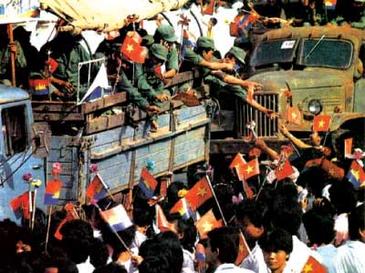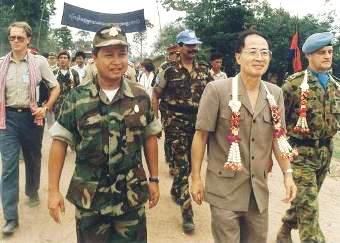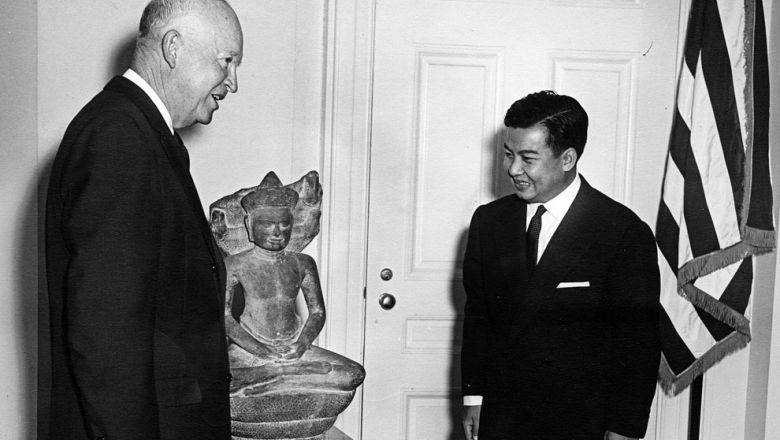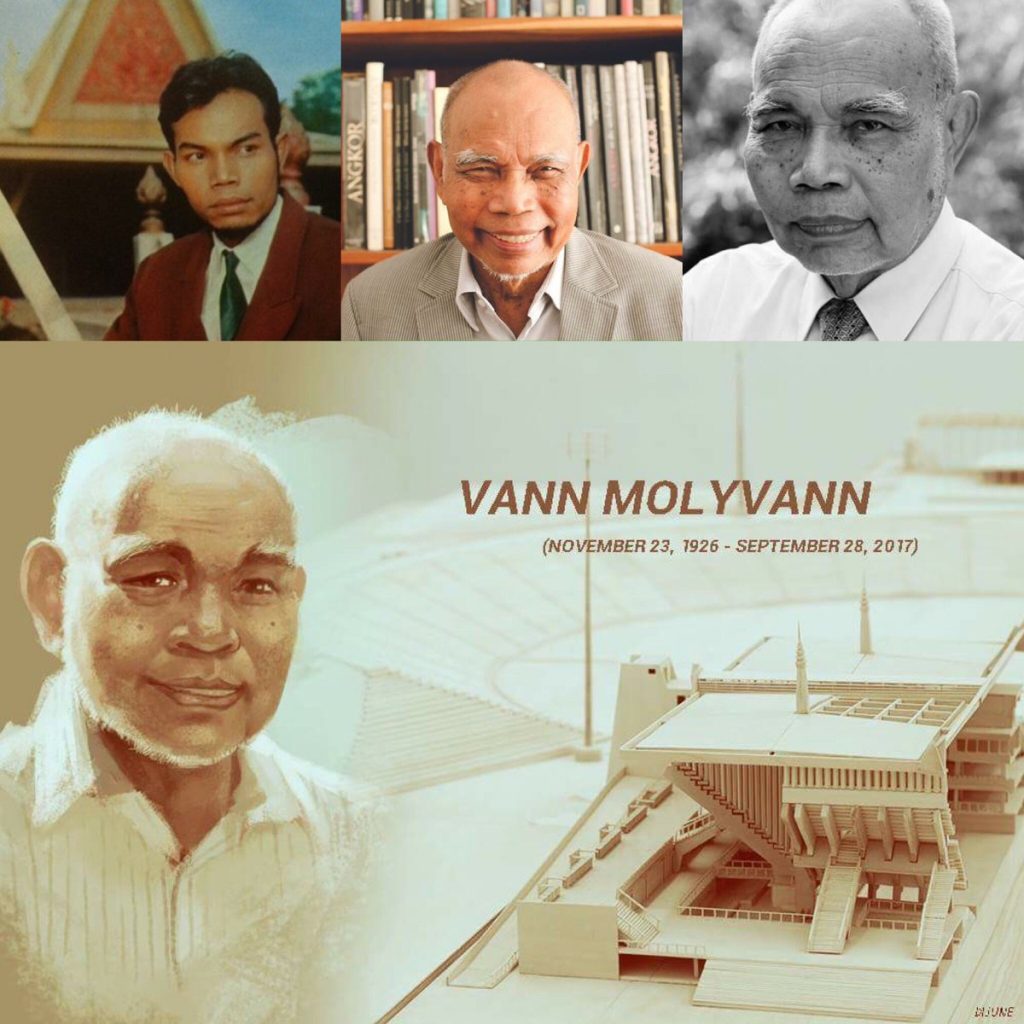On September 24, 1952, rebel groups The Khmer National Liberation Committee (Comite National Khmer de Liberation – CNKL) headed by Poc Khan, and The United Issarek Front (Front Uni Issarek – FUI) headed by Son Ngoc Minh (Thanh), formed a coalition.
On September 24, 1993, Prince Sihanouk signed the constitution into law, formally establishing the Kingdom of Cambodia. The Prince was elected King of Cambodia and sworn in on the same day.
On September 25, 1961, Prince Sihanouk met with President Kennedy in New York City while attending UN General Assembly session.

On September 25, 1961,President Kennedy’s Address to the United Nations:
“Finally, as President of the United States, I consider it my duty to report to this Assembly on two threats to the peace which are not on your crowded agenda, but which causes us, and most of you, the deepest concern.
“The first threat on which I wish to report is widely misunderstood: the smoldering coals of war in Southeast Asia. South Vietnam is already under attack–sometimes by a single assassin, sometimes by a band of guerrillas, recently by full battalions. The peaceful borders of Burma, Cambodia and India have been repeatedly violated. And the peaceful people of Laos are in danger of losing the independence they gained not so long ago.
“No one can call these ‘wars of liberation.’ For these are free countries living under governments. Nor are these aggressions any less real because men are knifed in their homes and not shot in the fields of battle.
“The very simple question confronting the world community is whether measures can be devised to protect the small and weak from such tactics. For if they are successful in Laos and South Vietnam, the gates will be opened wide.
On September 25, 1977, after more than two years in power, Pol Pot publicly revealed that Angkar was a Marxist–Leninist organisation, at a rally in the Olympic Stadium. Pol Pot revealed that ‘Angkar’ was a pseudonym for the Communist Party of Kampuchea.
On September 25, 1989, Khmer Rouge radio claimed its forces had captured “a major strategic position” on the road between the key towns of Battambang and Pailin in western Cambodia. Phnom Penh’s defense minister, Gen. Tea Banh, acknowledged the guerrillas have seized teritory near Pailin, but said the area remained under government control.
On September 26, 1958, as diplomatic tensions increased over China, it was decided that the U.S. should continue its program of military and economic aid in Cambodia (although decreased), subject to (1) availability of funds and (2) the nature of future developments.
On 26 September, 1989, the last Vietnamese forces formally withdrew from Cambodia.

On September 26, 1993, with a final flourish of pomp and fanfare, the United Nations ended its peace-keeping mission as Yasushi Akashi, the Japanese head of the operation, bid an emotional farewell to the newly reconstituted kingdom of Cambodia.
The U.N. Transitional Authority in Cambodia, known as UNTAC, officially completed its 18-month mission as the largest, most ambitious and most expensive U.N. peace-keeping operation to date.

On 26 September, 2014, a controversial deal was made between Cambodia and Australia, where refugees attempting to reach Australia would be rehomed in Cambodia, as part of a $35 million aid package. Immigration Minister Scott Morrison (now Australian PM) said:
“Cambodia is so keen to join that family of countries that can provide genuine resettlement, I think this is a very serious step forward,” Morrison said in an interview in Phnom Penh, where the two countries signed a memorandum of understanding on the resettlement plan. “They will have an opportunity of a life here … free of the persecution that made them flee their home countries.”
By 2016 a total of 6 refugees had been resettled in Cambodia, 4 soon returned to their homelands and another stated the wish to leave. By 2016 the program had cost Australian tax payers $4.77 million before the aid deals had been completed.
On 27 September 1954, the process of naturalisation went through amendments to the Civil Code (Kram No. 904-NS
and Kram No. 357-NS of 26 October 1959). These amendments emphasised that naturalisation was not a right, but a “favour’ exercised under administrative discretion. According to the new legislation, the applicant must:
• be of good character
• speak fluently Khmer and “demonstrate sufficient assimilation to the manners, customs and traditions of Cambodia”
• have five years of residency in Cambodia prior to the application
• reside in Cambodia at the time of the application, and
• not present a “physical or mental danger” or “a burden for the nation”.
On September 27, 1960, Sihanouk met with President Eisenhower in New York City while attending UN General Assembly session.

On September 27, 1989, Jim Leech, writing in the NYT called for Pol Pot to go on trial.
From September 28-October 2, 1949, French troops clashed with communist rebels in the Sri Chen (?) area .
On September 28, 1958, Sihanouk made an unofficial visit to Washington while attending UN General Assembly. He had arrived in U.S. on September 12. He stayed until October 3.
On September 28, 1959, Ambassador Trimble’s Letter Concerning U.S. Aid to Cambodia. READ
On September 28, 1960, leaders of the Khmer People’s Revolutionary Party (KPRP) held a three-day congress in Phnom Penh. They voted to reform as the Workers’ Party of Kampuchea (WPK). 21 Cambodian Communists were present at the secret meeting held in Phnom Penh railway station. This meeting is considered to have been the founding point of the ‘Khmer Rouge’ movement dominated by Pol Pot, Ieng Sary and Nuon Chea. *Other sources put the meeting on September 30-October 2.
On September 28, 1964, Chairman Mao Zedong met with Prince Sihanouk. They discussed previous and present Chinese-American relations, focusing especially on Taiwan and Communist reading material. Excerpts can be read HERE.

On September 28, 2017, the father of neo-Khmer architecture Vann Molyvann died at his home in Siem Reap city, aged 90.

On September 28, 1949, after being ousted by Ieu Koeus on September 20, 1949, Yem Sambaur returned to office as Prime Minister for the second time.
On September 29, 1961, Thailand released a COUNTER-MEMORIAL on the disputed areas around Preah Vihear.
On September 29, 2011, Carol Rodley, the only woman to hold the position of US Ambassador, left the post.

On September 30, 2010, a sub-committee of the House of Representatives held a hearing ‘Cambodia’s Small Debt: When Will The US Forgive?‘ Loans to the Khmer Republic from 1972-75 had, with interest, grown to $444.4 million by 2010.
